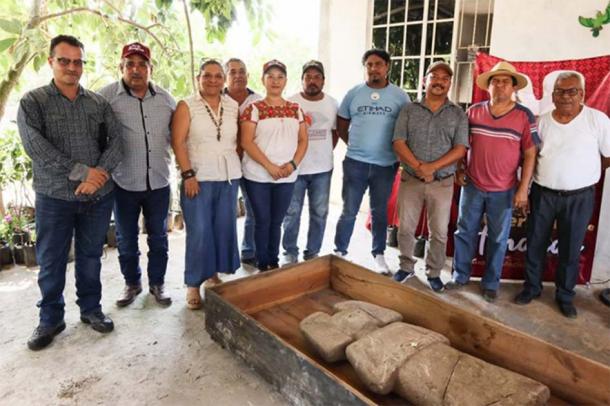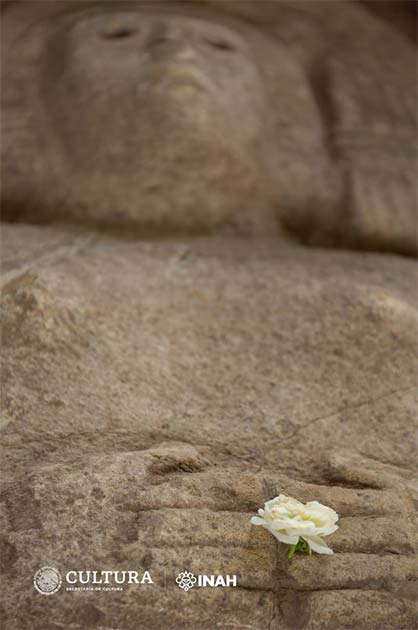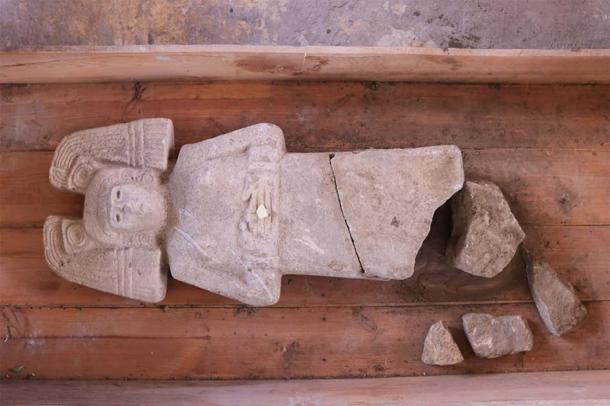
Statue of Huastec ‘Boss’ Found by Road Workers in Mexico
Road works in Hidalgo, Mexico, hit a snag when workers unearthed a rare stone statue. Turns out, it's a boss-level indigenous ruler who got relocated for his own safety, according to Mexican archaeologists.
Before we look at the statue, let’s first dig into Huastec culture to better contextualize the discovery. Cultivating maize, beans and squash, the Huastec civilization flourished between 1000 BC to 1500 AD along the Pánuco River, and along the coast of the Gulf of Mexico, in what is today Mexico. Known for their impressive, decorated pottery and textiles, the Huastec people developed a complex social structure and polytheistic religion.

Archaeologists during press conference presenting the Huastec statue in Mexico. (INAH)
The Pyramids and Pyramidal Society of the Huastecs
The most famous architectural work associated with the Huastec civilization is the Pyramid of the Niches, located in the ancient city of El Tajín, Veracruz. Renowned for its numerous recessed niches on its façade, these portals are thought to have held sacred sculptures depicting the chief gods of the diverse pantheon of the Huastecs. In this world, sitting just below the tlahtohqueh, or ruler/lord in the Huastec language, a fleet of elite regional rulers held political and religious authority over their respective territories.
- Archaeologists Unearth Trinket Filled Tombs from Mexico’s Huastec Culture
- The Lost Zapotec: Vibrant Mesoamerican Civilization of The Cloud People
The Huastecs were eventually conquered by the Aztecs during the 15th century AD, and they finally collapsed under the Spanish conquest between 1519 and 1530s, at which time they were subsequently transported to the Caribbean and sold as slaves. And with this ancient culture having been so fragmented, and almost lost in time, the discovery of a statue depicting a Huastec ruler is big news for this region of Mexico.

The Huastec statue was unearthed during road works in Mexico. (Gerardo Peña / INAH)
Huastec Ruler Probably Buried for His Own Safety
The Central Mexican community of Hidalgo Amajac is located in the municipality of Álamo Temapache, in the state of Veracruz. It was here that road workers recovered the statue of a “young ruler of Amajac.” According to archaeologists from the National Institute of Anthropology and History (INAH), the statue depicts “a local ruler wearing a ceremonial headdress.”
The Huastec statue weighs between 200 and 250 kilograms (440.92 - 551.16 lbs) and measures 1.54 meters (5.05 ft) in height. The INAH archaeologists said the statue is similar to other examples of rulers found in the pre-Columbian city of El Tajín, in the Mexican state of Veracruz.
Archaeologists investigating the recent discovery of the Huastec statue dated it to the Early Postclassic period, between 1100 AD and 1200 AD. The INAH researchers said the figure was most likely “removed from a public space and buried for protection.”
In 2021, the statue of an indigenous woman wearing a headdress and an ankle-length skirt, which has come to be known as the Young Woman of Amajac, was found in an orange grove. The statue measured 2 meters (6.56 ft) in height. According to a report from Heritage Daily, Mayor Lilia Arrieta Pardo of Álamo Temapache announced that a cultural space under construction in Hidalgo Amajac will soon showcase the recently discovered statue along with the Young Woman of Amajac.

Archaeologists believe that the Huastec statue was buried for its own protection. (Gerardo Peña / INAH)
Why All This Fuss Over One Huastec Statue?
Hidalgo state in Mexico has a rich archaeological history, and it features, for example, Tula de Allende which is renowned for ancient Toltec ruins including the impressive Pyramid of Quetzalcoatl. This, and other archaeological sites, like Xihuingo and Tepeapulco, provide rich insights into the pre-Columbian civilizations that once thrived in this region of modern Mexico.
- Mexican Farmers Unearth Ancient Statue of Elite Mesoamerican Woman
- Tlazolteotl: An Ancient Patroness and Purifier for all things Filthy
The decline and demise of the Huastec civilization can be attributed to the arrival of Spanish conquistadors and the subsequent colonization of Mexico, led by Hernán Cortés in the early 16th century. At this time the Huastec people were introduced to smallpox, which devastated the indigenous populations, and the conquest resulted in forced labor (slavery) and the destruction of traditional social and economic structures.
After extreme repression, the Huastec people lost their autonomy, and the impact of diseases, warfare and social upheaval, accelerated their decline. This is why these two statues are of such high-archaeological and cultural value, for they serve as rare tangible remnants of a once rich cultural heritage, whose ancient traditions only exist today in small Huastec communities.
Top image: Detail of the Huastec statue which was discovered in Mexico. Source: INAH
By Ashley Cowie















